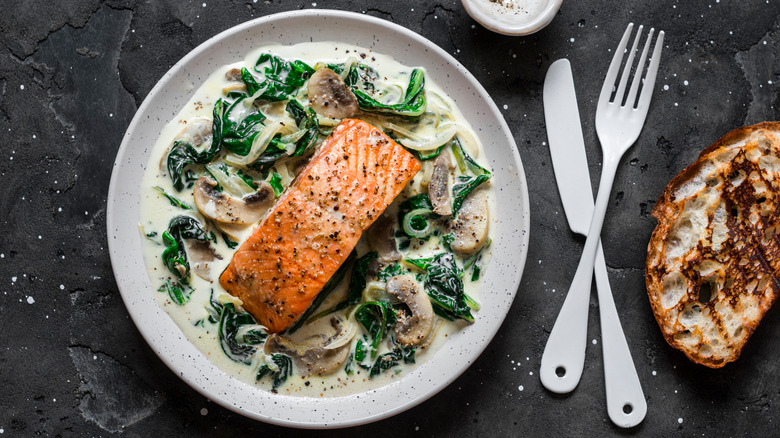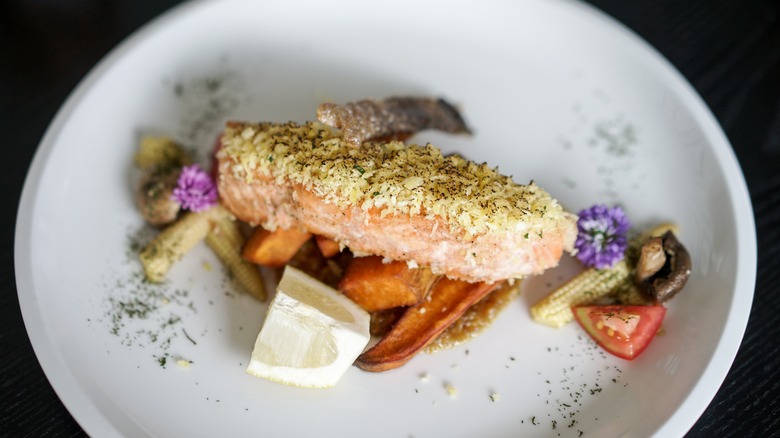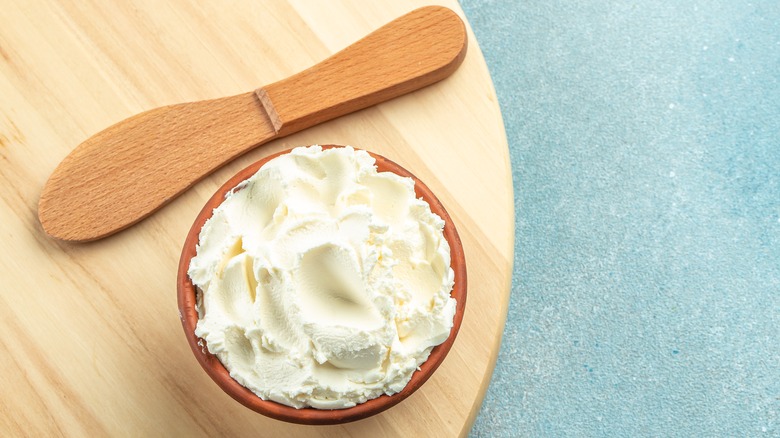The Creamy Ingredient That Takes Baked Salmon To The Next Level
When it's done well, baked salmon is tender, flaky, and full of flavor. But if you find that it sometimes can be dry or bland, just add cream cheese. The fresh dairy favorite is deliciously rich, as regular cream cheese must, by definition, contain at least 33% fat, according to the USDA. This gives the product a gorgeously silky mouthfeel, which enriches savory dishes such as baked salmon as well as sweet desserts like a no-bake dark chocolate Oreo cheesecake.
Cream cheese is made by adding lactic acid to pasteurized milk and cream. In addition to giving it a tangy taste, the lactic acid in the dairy product helps keep the salmon moist — similar to the way that a yogurt marinade is key to extra-juicy chicken. Lactic acid is gentler than other types, like citric or the acetic acid found in vinegar. It also helps protein absorb more water, which it retains during cooking. Adding cream cheese to salmon prior to baking will result in a plump, juicy, and succulent piece of fish.
In addition to the textural boost, the acid in cream cheese pairs perfectly with rich salmon in a similar way to how lemon does, adding a boost of bright flavor; just think of how well the combo works on a classic smoked salmon bagel. When using this soft cheese for cooking, there are several ways you can incorporate it with baked salmon for a great result every time.
How to bake salmon with cream cheese
One of the easiest ways to add cream cheese to salmon is to simply top the fish with the dairy product before it goes in the oven. Try mixing it with garlic, salt, pepper, and grated lemon zest for extra flavor. You could add Parmesan, soy, or miso to the soft cheese for an umami-rich result, or fresh herbs such as chopped chives or parsley for a fragrant finish. To enhance the texture further, sprinkle seasoned breadcrumbs on top of the creamy mixture before you bake the fish. You'll get a crispy crust that contrasts beautifully with the soft salmon.
You can also use cream cheese to make a rich and luscious sauce for baking salmon. Simply whisk it with boiling water and a squeeze of lemon, then pour the mixture over the fish for the final five minutes of cooking time. It's especially good if you're preparing the salmon as part of a traybake with other vegetables such as peas, zucchini, or asparagus, as they also work beautifully with the creamy sauce.
Alternatively, you can turn cream cheese into a quick pan sauce by heating it with milk and a couple of tablespoons of pesto for a more punchy flavor. Just drizzle it over the fish once it's cooked. As for how long to bake salmon to keep it tender, a good rule of thumb is eight minutes for each inch of thickness of the fillet you're cooking.
More tips for cooking with cream cheese
To ensure your cream cheese spreads smoothly over fish, it's best to bring it to room temperature before you begin. To keep things safe, don't leave the cream cheese out to soften on the counter, and certainly don't leave it out of the refrigerator for more than two hours, according to USDA guidelines. Instead, beat it with a hand mixer to soften it faster, or you could also heat it gently in the microwave in 10-second bursts.
If you don't have any cream cheese on hand, you can make your own. The process involves bringing a mixture of heavy cream, milk, plain yogurt, and kosher salt to the boil, adding a little white vinegar, and letting it cool. Strain it into a bowl and refrigerate overnight; the resulting creamy mixture will keep for a couple of weeks when refrigerated. Mix in some freshly chopped herbs or lemon zest to create your own cream cheese flavor to pair perfectly with the salmon — or you could use it for baking chicken, too.
To add further richness when baking salmon, use equal amounts of cream cheese and mascarpone to top the fish before cooking. Alternatively, try mixing together sour cream, wholegrain mustard, and Parmigiano-Reggiano or parmesan and spreading it onto the filets for a tangy and deliciously savory result.



